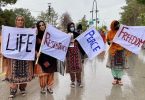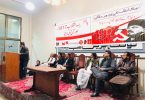By Lal Khan
It’s ultimately the mass militant movements of the oppressed classes that defy and cut across the prevalent narratives of a society and situation imposed by the corporate media, the ruling class politics and the bourgeois states. The movement in Kashmir that erupted in July 2016 has precisely done so. It has not only defied of the atrocious oppression of the reactionary Indian state upon the Kashmiris under its occupied part of the territory but movement’s character and visage has negated the frivolous assertions of it being religious and chauvinist. The ‘Freedom’ slogan means much more than the narrow nationalism. This struggle is about the will and determination of Kashmir’s oppressed people to achieve their national, social, economic and cultural emancipation.
Students and youth are in the vanguard of this mass revolt that has defied the fifth largest military in the world with the most concentrated deployment against ordinary people anywhere on this planet. Such is the valour of this upsurge that after every assault and shootout by the army a reinvigorated wave of mass protests erupts almost instantaneously. The growing support and shielding of the rebels in an armed struggle by the ordinary people is unforeseen. No external power’s support can be as supportive for any insurgency as that of the indigenous population.
As gunfights break out between state forces and the rebels, the youth rush to the scene to distract the military’s assaults and pave the escape routes for the insurgents. The Hindutva rulers in Delhi and the top brass of the army are baffled and exasperated by the resilience of this new wave of the revolt. The disgusting bluster of gallantry of the Indian army being churned out by the Hindu chauvinist corporate media houses cannot conceal the despondent condition of India’s state in Kashmir.
A recent Indian Express article, titled Sinking Valley, lays bare this pathetic situation; “ Every element of Indian policy in Kashmir lies in tatters…seems to be going from a deep and violent conflict to a state where there seems to be a death wish all around: Security forces with no means to restore order other than by inflicting death, Indian nationalism now more interested in showing machismo than solving real problems, increasingly radicalised militancy with almost a touch of apocalyptic disregard for life, foreign powers fishing in troubled waters, scores of young men and children even, who are making a statement that courting death seems a better option than what they regard as suffocating oppression…but we are looking at a situation where our strategy of containment by force has failed, our political instruments are hollow, and there is a deepening death wish in the state. Kashmir is looking at an abyss.”
The UK-based Chatham House survey in May 2010, before a summer uprising 43 percent of respondents in the whole of the Indian occupied Kashmir said they would vote for Kashmir to become independent, while 28 percent said they would vote to join India. However, in the Kashmir Valley, between 75 and 95 percent supported independence. The upsurge has drastically shrunk the base for India-backed political parties whose leaders are afraid even to return home. The legitimacy of almost all conventional political parties inclusive in the Indian political set up from the PDP to the National Conference has eroded although their mass base was always tenuous. These are no more credible instruments for Delhi in its desperate bid of conciliating Kashmiris. It seems that there is no room left for a dialogue to address these Kashmiris who have suffered brutally from state oppression. The option of a negotiated settlement seems to have been lost at the present moment in time and that means Kashmir’s parting from India in their hearts and minds in spite of its occupation.
On April 9, during parliamentary by-elections in central Kashmir, people boycotted with only 7 percent of voters casting ballots— the lowest in thirty years. The regime cancelled the next phase of elections to be held in four districts. Eight people were killed by the military brutality during the anti-election protests where polling stations were ransacked and voting machines burnt by defiant demonstrators.
Today’s Kashmir is in a state of rebellion and radicalisation yet unforeseen. The Modi Sarkar’s justified this shocking debacle as people’s fear from the threat of violence! But that’s the point of every insurgency wants to make. Paralyse the state’s usual functioning. Paradoxically it illustrates the success of the aims of the armed struggle and is as stinging rebuke to New Delhi’s counter-insurgency strategy and failure of the brute state repression to subdue a people in an audacious vein of an uprising.
It’s also true that there has been infiltration by foreign states in Kashmir for their vested interests. Pakistan’s involvement with religious jihadist groups for decades is no secret. But what we are witnessing is that the Indian ruling elite and the state has never felt so threatened and vulnerable from foreign interventions that they are from this indigenous revolt. The mammoth military apparatus and might of the Indian bourgeois seem to be helpless and despairing in the face of these stone throwing girls and boys who have risen with a vengeance against the oppression and cruelties executed by this ‘largest democracy in the world’. Terrorism from across the LoC was used as a pretext to crush the masses in the past. This time round the passion and verve of the upheaval cut across and exposed these pretentions. In the past, they have exploited the acts of foreign-sponsored terror outfits as alibis to crush the rising movements in Kashmir.
In the last analysis, individual terrorism and sectarian violence become a tool for the repressive bourgeois states to divide the people and crush movements by ferocious state terrorism. The Indian state has also been fostering its own Islamic fundamentalist groups for decades. Most of these sectarian groups are used to eliminate the genuine activists in struggle and those in the struggle on a class and national basis. During the recent uprising, there have been attacks and killings that were being carried out at the directives of Indian agencies and were widely condemned. There have been mysterious killings in the last few months but condemnations by the media and the state were muted and reserved.
The territory that comprises Kashmir is inhabited by various ethnic, religious and cultural diversities. The people living in the Valley, Ladakh, Jammu region and areas across the LoC belong to these various ethnicities, religions and races. Religious and sectarian prejudices and hatreds only divide the peoples of the region. The ‘Trifurcation’ of Kashmir as advocated by the RSS for a long time and reiterated not long ago by L.K. Advani is the strategy of divide and rule of Hindutva. It means that such ideological divisions of the Islamicist fanatics in Kashmir play directly into the hands of the rulers in New Delhi. Similarly, the belligerence and prejudices against Muslims by the Hindutva are beneficial for the Islamicists whipping up a religious frenzy to enhance their support base. In other words, these religious reactionaries feed upon each other for their political sustenance.
A campaign around a narrow Kashmiri nationalism on a geographical basis and with the aim of creating a bourgeois Kashmiri independent state on a capitalist basis can also end up dividing the various communities. With the abandonment of socialist and class content of the struggle for Kashmiri national liberation has resulted in the decline of the nationalist parties. This gave way to the Islamicist sectarian clergy to make inroads in the movement. The right of the self-determination and independence, if the majority so wishes, is a genuine claim of the peoples of Kashmir.
However to defeat the oppressive states occupying Kashmir and using it as a foreign policy instruments is a task that needs a class unity and struggle of revolutionary magnitudes. The Kashmiri ruling classes have been protégés of these states. This bourgeois has been an accomplice in the subjugation of the Kashmiri masses. This is the crucial concern where the class unity becomes indispensable.
Lenin was profound on this issue: “The recognition of the right to self –determination does not exclude either propaganda or agitation against separation or exposure of bourgeois nationalism.”
In the last seventy years, while the people of Kashmir were being brutalised and subcontinents masses are the victims of capitalist drudgery, nothing has been resolved. The UN and other international diplomatic forums dominated by imperialism and big powers failed to move even an inch in the resolution of the Kashmir’s agony. The ruling classes of India and Pakistan have been talking for talks for those long tragic years. They cannot and do not want to resolve this issue. Their vested state and monetary interests forbid that. Wars have only convulsed the issue further impoverishing and agonising the lives of the ordinary Kashmiri’s. Armed struggle failed to dislodge the imperial occupational states. When all options are closed then only the revolutionary way out remains to end the plight of the oppressed.
However if to unite all the oppressed people in different parts of the geographical entity known as Kashmir a class unity is essential, it is also crucial to get the support of the youth and working classes in the struggle to break the shackles of these mighty states that oppress the Kashmiri masses. The national liberation of the Kashmir is linked intrinsically to the class struggle and a socialist transformation across the South Asian subcontinent.






